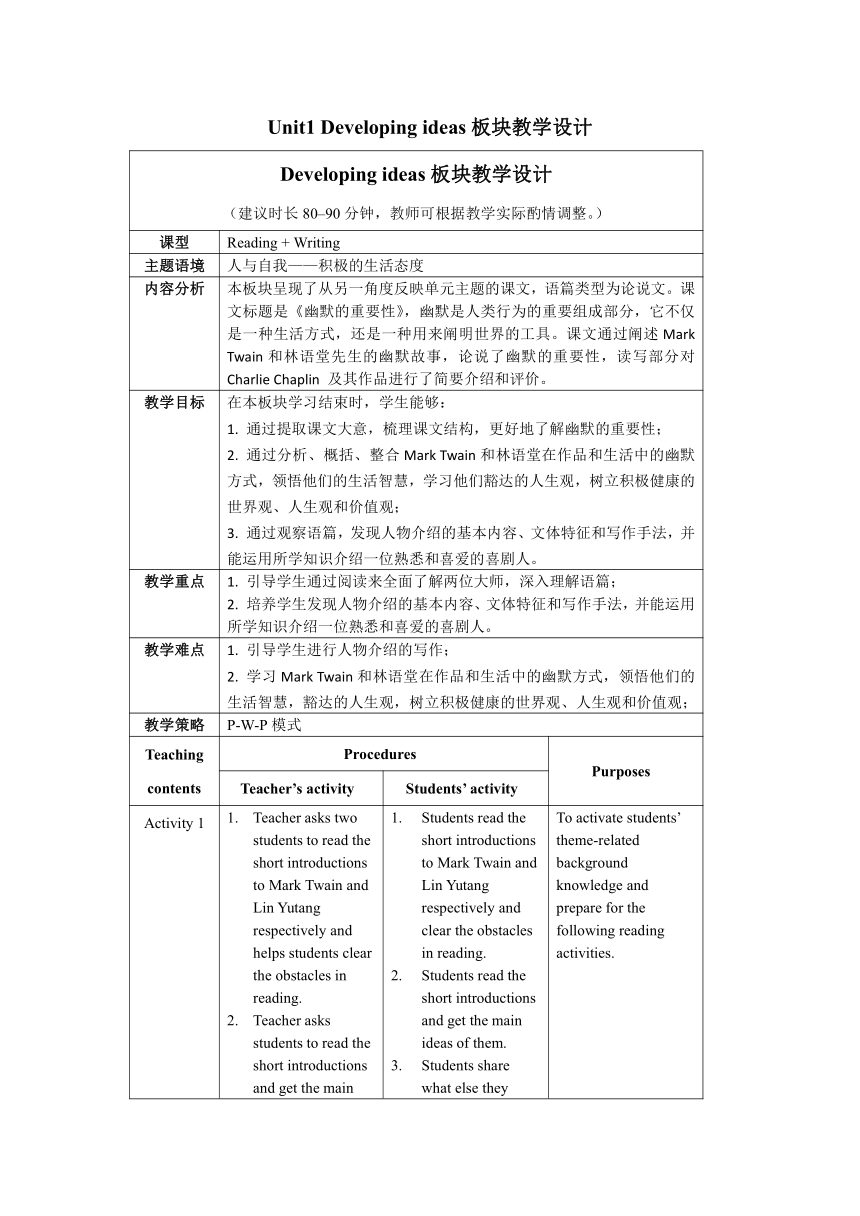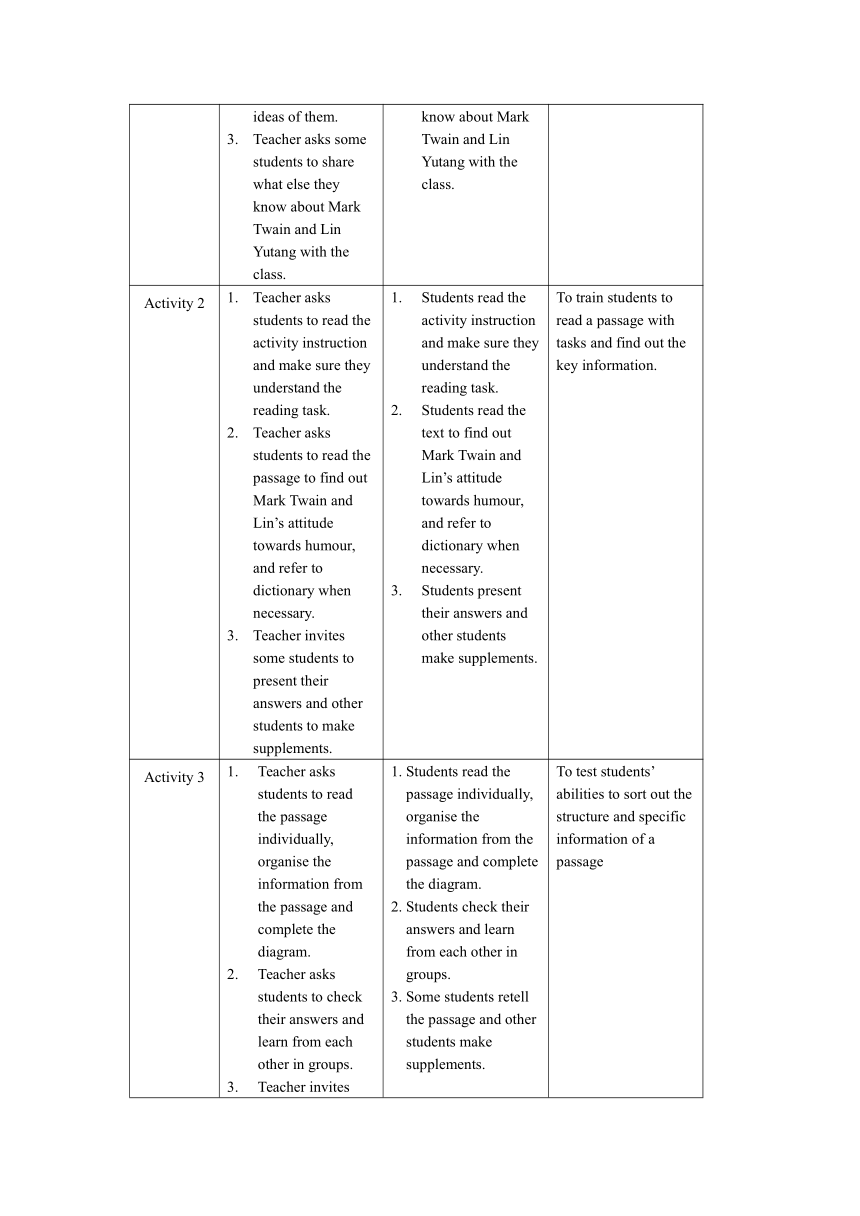外研版(2019)高中英语选择性必修第一册 Unit1 Laugh out loud! Developing ideas 板块教学设计(表格式)
文档属性
| 名称 | 外研版(2019)高中英语选择性必修第一册 Unit1 Laugh out loud! Developing ideas 板块教学设计(表格式) |  | |
| 格式 | docx | ||
| 文件大小 | 24.8KB | ||
| 资源类型 | 教案 | ||
| 版本资源 | 外研版(2019) | ||
| 科目 | 英语 | ||
| 更新时间 | 2023-03-02 10:37:24 | ||
图片预览


文档简介
Unit1 Developing ideas板块教学设计
Developing ideas板块教学设计 (建议时长80–90分钟,教师可根据教学实际酌情调整。)
课型 Reading + Writing
主题语境 人与自我——积极的生活态度
内容分析 本板块呈现了从另一角度反映单元主题的课文,语篇类型为论说文。课文标题是《幽默的重要性》,幽默是人类行为的重要组成部分,它不仅是一种生活方式,还是一种用来阐明世界的工具。课文通过阐述Mark Twain和林语堂先生的幽默故事,论说了幽默的重要性,读写部分对 Charlie Chaplin 及其作品进行了简要介绍和评价。
教学目标 在本板块学习结束时,学生能够: 通过提取课文大意,梳理课文结构,更好地了解幽默的重要性; 通过分析、概括、整合Mark Twain和林语堂在作品和生活中的幽默方式,领悟他们的生活智慧,学习他们豁达的人生观,树立积极健康的世界观、人生观和价值观; 3. 通过观察语篇,发现人物介绍的基本内容、文体特征和写作手法,并能运用所学知识介绍一位熟悉和喜爱的喜剧人。
教学重点 1. 引导学生通过阅读来全面了解两位大师,深入理解语篇; 2. 培养学生发现人物介绍的基本内容、文体特征和写作手法,并能运用所学知识介绍一位熟悉和喜爱的喜剧人。
教学难点 1. 引导学生进行人物介绍的写作; 2. 学习Mark Twain和林语堂在作品和生活中的幽默方式,领悟他们的生活智慧,豁达的人生观,树立积极健康的世界观、人生观和价值观;
教学策略 P-W-P模式
Teaching contents Procedures Purposes
Teacher’s activity Students’ activity
Activity 1 Teacher asks two students to read the short introductions to Mark Twain and Lin Yutang respectively and helps students clear the obstacles in reading. Teacher asks students to read the short introductions and get the main ideas of them. Teacher asks some students to share what else they know about Mark Twain and Lin Yutang with the class. Students read the short introductions to Mark Twain and Lin Yutang respectively and clear the obstacles in reading. Students read the short introductions and get the main ideas of them. Students share what else they know about Mark Twain and Lin Yutang with the class. To activate students’ theme-related background knowledge and prepare for the following reading activities.
Activity 2 Teacher asks students to read the activity instruction and make sure they understand the reading task. Teacher asks students to read the passage to find out Mark Twain and Lin’s attitude towards humour, and refer to dictionary when necessary. Teacher invites some students to present their answers and other students to make supplements. Students read the activity instruction and make sure they understand the reading task. Students read the text to find out Mark Twain and Lin’s attitude towards humour, and refer to dictionary when necessary. Students present their answers and other students make supplements. To train students to read a passage with tasks and find out the key information.
Activity 3 Teacher asks students to read the passage individually, organise the information from the passage and complete the diagram. Teacher asks students to check their answers and learn from each other in groups. Teacher invites some students to retell the passage and other students to make supplements. 1. Students read the passage individually, organise the information from the passage and complete the diagram. 2. Students check their answers and learn from each other in groups. 3. Some students retell the passage and other students make supplements. To test students’ abilities to sort out the structure and specific information of a passage
Think & Share Teacher asks students to work in pairs to discuss the four questions. Teacher asks students to answer the questions and other students to make supplements or free discussion. Students work in groups to discuss the four questions. Some students answer the questions and other students make supplements or free discussion. To help students further explore the topic. To improve students’ critical thinking ability. To help students apply what they’ve learnt in a real-life context.
Activity 4 Teacher asks students to read the equation from the passage, think of it and try answering the questions individually. Teacher asks students to work in groups to fully express their own opinions and give reasons. Teacher asks some groups to share their opinions of the equation and others make comments. Teacher asks students to pay close attention to self-evaluation and think about their performances in this activity. Teacher makes advice to improve students’ performances. Students read the equation from the passage, think of it and try answering the questions individually. Students work in groups to fully express their own opinions and give reasons. Some groups share their opinions of the equation and others make comments. Students think about their performances in this activity. To inspire students to think the author’s attitude and the value of the passage and cultivate students’ ability to think creatively.
Activity 5 Teacher asks students to share the information about Charlie Chaplin that they have known. Teacher asks students to read the blog post quickly and match the headings to the paragraphs. Teacher checks the answers with the students. Students share the information about Charlie Chaplin that they have known. Read the blog post quickly and match the headings to the paragraphs. Students check the answers with the teacher. To train students’ reading skills.
Activity 6 Teacher asks students to read the passage again and find out the specific information in this activity. Teacher asks students to work in groups to discuss the specific information and how the author presents it. Teacher asks students to check the answers with the class. Students read the passage again and find out the specific information in this activity. Students work in groups to discuss the specific information and how the author presents it. Some students answer the questions and other students check the answers. To teach students how to analyse a passage, and prepare for the following writing activity.
Activities 7-8 Teacher asks students to read the passage in activity 5 and analyse the structure of it. Teacher asks students to choose a comedian and complete the notes. Teacher asks students to write a short introduction of the comedian according to the notes they made. Teacher asks students to work in pairs and make improvements to each other’s introductions. Teacher asks students to share their introductions with the class. Teacher and other students make comments. Teacher asks students to polish their writing and post them on their social media. Students read the passage in activity 5 and analyse the structure of it. Students choose a comedian and complete the notes. Students write a short introduction of the comedian according to the notes they made. Some students work in pairs and make improvements to each other’s introductions. Some students share their introductions with the class. Others make comments. Students polish their writing and post them on their social media. To provide opportunities for students to present their writing and do evaluation.
Developing ideas板块教学设计 (建议时长80–90分钟,教师可根据教学实际酌情调整。)
课型 Reading + Writing
主题语境 人与自我——积极的生活态度
内容分析 本板块呈现了从另一角度反映单元主题的课文,语篇类型为论说文。课文标题是《幽默的重要性》,幽默是人类行为的重要组成部分,它不仅是一种生活方式,还是一种用来阐明世界的工具。课文通过阐述Mark Twain和林语堂先生的幽默故事,论说了幽默的重要性,读写部分对 Charlie Chaplin 及其作品进行了简要介绍和评价。
教学目标 在本板块学习结束时,学生能够: 通过提取课文大意,梳理课文结构,更好地了解幽默的重要性; 通过分析、概括、整合Mark Twain和林语堂在作品和生活中的幽默方式,领悟他们的生活智慧,学习他们豁达的人生观,树立积极健康的世界观、人生观和价值观; 3. 通过观察语篇,发现人物介绍的基本内容、文体特征和写作手法,并能运用所学知识介绍一位熟悉和喜爱的喜剧人。
教学重点 1. 引导学生通过阅读来全面了解两位大师,深入理解语篇; 2. 培养学生发现人物介绍的基本内容、文体特征和写作手法,并能运用所学知识介绍一位熟悉和喜爱的喜剧人。
教学难点 1. 引导学生进行人物介绍的写作; 2. 学习Mark Twain和林语堂在作品和生活中的幽默方式,领悟他们的生活智慧,豁达的人生观,树立积极健康的世界观、人生观和价值观;
教学策略 P-W-P模式
Teaching contents Procedures Purposes
Teacher’s activity Students’ activity
Activity 1 Teacher asks two students to read the short introductions to Mark Twain and Lin Yutang respectively and helps students clear the obstacles in reading. Teacher asks students to read the short introductions and get the main ideas of them. Teacher asks some students to share what else they know about Mark Twain and Lin Yutang with the class. Students read the short introductions to Mark Twain and Lin Yutang respectively and clear the obstacles in reading. Students read the short introductions and get the main ideas of them. Students share what else they know about Mark Twain and Lin Yutang with the class. To activate students’ theme-related background knowledge and prepare for the following reading activities.
Activity 2 Teacher asks students to read the activity instruction and make sure they understand the reading task. Teacher asks students to read the passage to find out Mark Twain and Lin’s attitude towards humour, and refer to dictionary when necessary. Teacher invites some students to present their answers and other students to make supplements. Students read the activity instruction and make sure they understand the reading task. Students read the text to find out Mark Twain and Lin’s attitude towards humour, and refer to dictionary when necessary. Students present their answers and other students make supplements. To train students to read a passage with tasks and find out the key information.
Activity 3 Teacher asks students to read the passage individually, organise the information from the passage and complete the diagram. Teacher asks students to check their answers and learn from each other in groups. Teacher invites some students to retell the passage and other students to make supplements. 1. Students read the passage individually, organise the information from the passage and complete the diagram. 2. Students check their answers and learn from each other in groups. 3. Some students retell the passage and other students make supplements. To test students’ abilities to sort out the structure and specific information of a passage
Think & Share Teacher asks students to work in pairs to discuss the four questions. Teacher asks students to answer the questions and other students to make supplements or free discussion. Students work in groups to discuss the four questions. Some students answer the questions and other students make supplements or free discussion. To help students further explore the topic. To improve students’ critical thinking ability. To help students apply what they’ve learnt in a real-life context.
Activity 4 Teacher asks students to read the equation from the passage, think of it and try answering the questions individually. Teacher asks students to work in groups to fully express their own opinions and give reasons. Teacher asks some groups to share their opinions of the equation and others make comments. Teacher asks students to pay close attention to self-evaluation and think about their performances in this activity. Teacher makes advice to improve students’ performances. Students read the equation from the passage, think of it and try answering the questions individually. Students work in groups to fully express their own opinions and give reasons. Some groups share their opinions of the equation and others make comments. Students think about their performances in this activity. To inspire students to think the author’s attitude and the value of the passage and cultivate students’ ability to think creatively.
Activity 5 Teacher asks students to share the information about Charlie Chaplin that they have known. Teacher asks students to read the blog post quickly and match the headings to the paragraphs. Teacher checks the answers with the students. Students share the information about Charlie Chaplin that they have known. Read the blog post quickly and match the headings to the paragraphs. Students check the answers with the teacher. To train students’ reading skills.
Activity 6 Teacher asks students to read the passage again and find out the specific information in this activity. Teacher asks students to work in groups to discuss the specific information and how the author presents it. Teacher asks students to check the answers with the class. Students read the passage again and find out the specific information in this activity. Students work in groups to discuss the specific information and how the author presents it. Some students answer the questions and other students check the answers. To teach students how to analyse a passage, and prepare for the following writing activity.
Activities 7-8 Teacher asks students to read the passage in activity 5 and analyse the structure of it. Teacher asks students to choose a comedian and complete the notes. Teacher asks students to write a short introduction of the comedian according to the notes they made. Teacher asks students to work in pairs and make improvements to each other’s introductions. Teacher asks students to share their introductions with the class. Teacher and other students make comments. Teacher asks students to polish their writing and post them on their social media. Students read the passage in activity 5 and analyse the structure of it. Students choose a comedian and complete the notes. Students write a short introduction of the comedian according to the notes they made. Some students work in pairs and make improvements to each other’s introductions. Some students share their introductions with the class. Others make comments. Students polish their writing and post them on their social media. To provide opportunities for students to present their writing and do evaluation.
